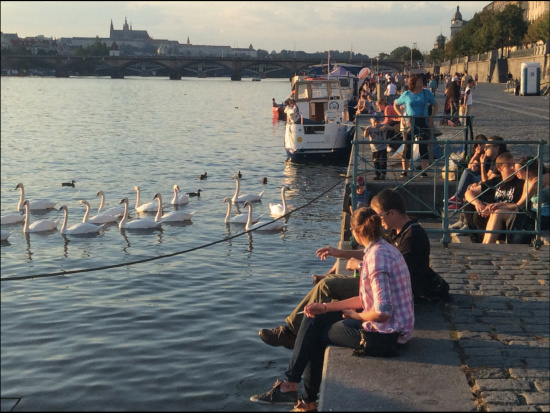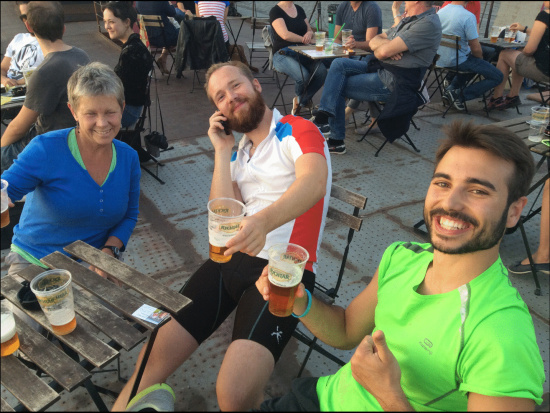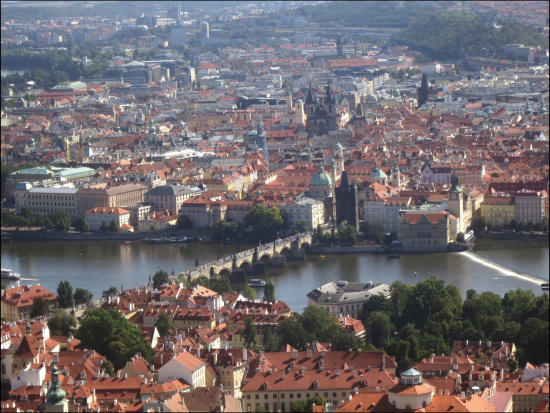The 14th century Charles Bridge (Karlův most) links the two sides of Prague across the Vltava River. (Barry Evans)
Louisa and I co-teach a travel class through OLLI (HSU extension program for 50+) two or three times a year. Some time during the first few minutes, I make a point of insisting that traveling to Europe (or more exotic places) is probably easier and cheaper than most of our participants think it is. The hardest part, I’ll say, is getting out of ACV – after that it’s smooth sailing.
We re-established that trite-but-usually-true adage just two weeks ago, flying from Arcata (or whatever it’s called these days) to Prague. The United flight (as if we have a choice) was nearly three hours late leaving Arcata, despite what both the website and the comforting customer service lady told us (“No more than 30 minutes delay”). No problem, we had a five hour scheduled layover at SFO. Ten hours later, we experienced German efficiency in Frankfurt, where passport control took all of five minutes, and from there it was a short hop to Prague. One hour later—having paid $30 for a SIM chip for for a month of cell service on my iPad Mini, claimed our folding bikes, and found a cab—we were ensconced in our fifth-story home-exchange apartment. Total travel cost for two: under $100 (having used frequent flyer miles—a whole algebra in itself). Bikes in boxes < 50 lb. and < 62 inches length+breadth+height travel free internationally.
Louisa with new pals David (from Prague) and Antonio (from Malaga), both in IT. (Barry Evans)
As I say, easy and cheap. What’s harder to get over to people who haven’t traveled much is the weirdness of it all. We left Eureka-home at 10 am, arrived at our Prague home around 6 pm the next day, and an hour later we were having a Czech beer with two cyclists we’d just met on the river embankment. Now this isn’t some expedition to the Red Planet we’re talking about, this is about as simple and hassle-free as you can get—and yet we might (almost) have been on Mars. It’s not exactly teleporting, but I still have this magical, other-worldly sense of disorientation, zipping from Old Town Eureka to Old Town Prague with barely a ripple in spacetime.
Mark Vanhoenacker, a British Airways pilot, has a new book out, Skyfaring: A Journey With a Pilot, in which he tries to pinpoint this weirdness. In an interview (NYT, 8/9/15), he says that “…place lag is the best term I could come up with for that bewilderment, which is something a lot more than culture shock or jet lag…you left London late at night and now it’s midafternoon and these great towers of clouds are rising off the Strait of Singapore and you look down and think, ‘This is just a whole other world.’” Despite his profession, he never accustoms to airplane-facilitated change of place.
The Vltava embankment. (Barry Evans) More photos on my Facebook page.
I know what he means, and share his conviction that we humans have trouble adapting to this place lag, having evolved with our entire lives spent in a comparatively tiny swath of forest or savannah. A day out from Eureka and I’m staring out over the Vltava quaffing Kvasar lager, red trams gliding by on the road above, rough Czech language filling the air, Prague’s towers and spires glinting in the sunset, and I’m basking in the sheer differentness of it all. Like the black-and-white to color switch in The Wizard of Oz, everything in this new environment appears wonderfully vibrant, immediate, crisp.
And, as I say, weird.



CLICK TO MANAGE